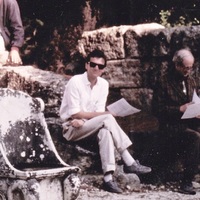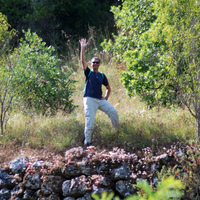Papers by E B Andersson
This article suggests an alternative to the common formal approach to Roman gardens. Traditional... more This article suggests an alternative to the common formal approach to Roman gardens. Traditional research has considered how the gardens were laid out and how they were planted, more important than which functions they filled. Here function refers to their use in relation to the architectural whole they are a part of, and not to the general distinction between "ornamental" and "domestic" gardens. To gain more understanding of their function, the author points to the evidence of the finds from gardens, which apart from sculpture, has seldom attracted much interest. (Summary on pages 96-97).
Latomus, 1991
The shape shifting of Dionysus: When metamorphoses from myths appear in Greek and Roman art, it ... more The shape shifting of Dionysus: When metamorphoses from myths appear in Greek and Roman art, it is for the most part only the central moment that is indicated, and the physical change in shape is left to the imagination of the viewer.
This study will point out, by means of a Roman monument, the possibility that water and fountains could represent one particular metamorphosis; the self-willed transformation of a god. The fountain as such may solve the artistic problem of how to represent a perpetually recurring metamorphosis and would in itself realize that metamorphosis by means of its iconography and water.
Latomus , 1991
In the previous upload of ‘Metamorphoses of Water’, PLATE IV and V (containing figures 3, 4 and 5... more In the previous upload of ‘Metamorphoses of Water’, PLATE IV and V (containing figures 3, 4 and 5) were missing. To correct this error and make the illustrations to the article complete, I have chosen to scan the missing plates and submit them here as an addendum.
Jahrbuch des Deutschen Archäologischen Instituts, 1990
The aim is to study ancient fountains in their architectural context, in the belief that the cont... more The aim is to study ancient fountains in their architectural context, in the belief that the context will reveal their function in the dwelling. This article first analyzes the fountain structures and examines the relationship between each structure and the architecture. Through this approach, it is possible to reach some conclusions of more general value, concerning the function of central parts of Roman houses.
Conference Presentations by E B Andersson
Archaeology and Economy in the Ancient World, vol.53 Heidelberg Propylaeum, 2022
Money chests or casseforti in situ could offer knowledge of where the core areas of economic acti... more Money chests or casseforti in situ could offer knowledge of where the core areas of economic activity in Pompeii were situated. Casseforti or platforms for such can be found in 30 locations in the city. There are archaeological indications from one house (Casa del Fauno) that slaves handled the money going into the chest, and kept accounts.
Money chests stood on platforms of stone or concrete. Stone platforms are considered to be the oldest. If the dating of stone platforms is correct, the considerable number of such indicates that Samnite Pompeii was a society in control of great financial resources. When we put this information into the historical context, this wealth may provide an additional reason for the military conquest of the city in the 1st century B.C.
Ancient economies in general relied strongly on their accessibility to currency. The distributio... more Ancient economies in general relied strongly on their accessibility to currency. The distribution of cash resources within the urban topography of Roman cities is therefore a topic that deserves attention. To accumulate greater amounts of cash money and other valuables, the Romans used, both public and private, a special money chest called arca, or arca ferrata.
The fact that private fountains surpass public fountains greatly in number is one of the conclusi... more The fact that private fountains surpass public fountains greatly in number is one of the conclusions of this paper, which also concerns the delivered quantity of water. The private fountains, and the revelation of their non-domestic display function, have produced knowledge that is incompatible with the modern urbanistic approach of how water supply to an ancient city should be viewed and understood.
There are very seldom taps in the domestic areas of the houses; rather the water, artistically di... more There are very seldom taps in the domestic areas of the houses; rather the water, artistically displayed, meets a visitor in the atrium.
In peristyles or gardens, many different types of fountains have been documented, but triclinia gathered around small water basins seem to have been especially popular.











Uploads
Papers by E B Andersson
This study will point out, by means of a Roman monument, the possibility that water and fountains could represent one particular metamorphosis; the self-willed transformation of a god. The fountain as such may solve the artistic problem of how to represent a perpetually recurring metamorphosis and would in itself realize that metamorphosis by means of its iconography and water.
Conference Presentations by E B Andersson
Money chests stood on platforms of stone or concrete. Stone platforms are considered to be the oldest. If the dating of stone platforms is correct, the considerable number of such indicates that Samnite Pompeii was a society in control of great financial resources. When we put this information into the historical context, this wealth may provide an additional reason for the military conquest of the city in the 1st century B.C.
In peristyles or gardens, many different types of fountains have been documented, but triclinia gathered around small water basins seem to have been especially popular.
This study will point out, by means of a Roman monument, the possibility that water and fountains could represent one particular metamorphosis; the self-willed transformation of a god. The fountain as such may solve the artistic problem of how to represent a perpetually recurring metamorphosis and would in itself realize that metamorphosis by means of its iconography and water.
Money chests stood on platforms of stone or concrete. Stone platforms are considered to be the oldest. If the dating of stone platforms is correct, the considerable number of such indicates that Samnite Pompeii was a society in control of great financial resources. When we put this information into the historical context, this wealth may provide an additional reason for the military conquest of the city in the 1st century B.C.
In peristyles or gardens, many different types of fountains have been documented, but triclinia gathered around small water basins seem to have been especially popular.